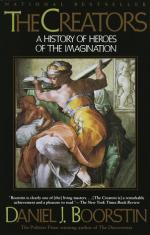
|
| Name: _________________________ | Period: ___________________ |
This test consists of 5 multiple choice questions, 5 short answer questions, and 10 short essay questions.
Multiple Choice Questions
1. When does Boorstin say Stonehenge was created?
(a) 2,000 B.C.
(b) 10,000 B.C.
(c) 500 A.D.
(d) 5,000 B.C.
2. Of what is Dionysus the god according to Boorstin?
(a) Warfare and strife.
(b) Hunting and weaponry.
(c) Craft and technology.
(d) Drama, dance and music.
3. What did the dithyramb and its derivatives do in Greek history?
(a) Explore the territories around Greece.
(b) Define Greek metaphysics.
(c) Provide a foundation for mathematical logic.
(d) Glorify Greece.
4. How does Boorstin characterize the Decameron?
(a) Panoramic.
(b) Autobiographical.
(c) Chaste.
(d) Sacred.
5. In what does Boorstin say Rabelais' book was an act of faith?
(a) Culture.
(b) God.
(c) Literary history.
(d) Language.
Short Answer Questions
1. What experience does Boorstin say Dante described in the Divine Comedy?
2. In what does Boorstin say Pantagruel luxuriates?
3. What does Boorstin say Moses introduced into Western culture?
4. What was the Romans' principal building material in Boorstin's opinion?
5. What does Boorstin say Paleolithic man discovered in making images?
Short Essay Questions
1. How does Boorstin describe the difference between tragedy and comedy?
2. How does Boorstin describe the Hindu contribution to imaginative culture?
3. How does Boorstin characterize the Gothic style of art?
4. How does Boorstin characterize Cervantes' contribution to imaginative literature?
5. What did Moses add to the culture of imagination?
6. What does Boorstin mean when he says that theology was born in Greek philosophy?
7. What contribution did the Egyptians make in building the pyramids?
8. How does Boorstin characterize the Confucian teachings?
9. What does Boorstin say is the importance of megaliths?
10. How do Muslims differ from Greeks and Christians in their approach to making images?
|
This section contains 726 words (approx. 3 pages at 300 words per page) |

|




